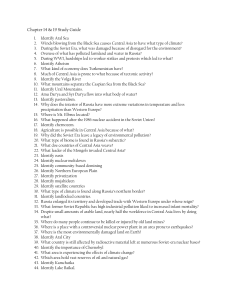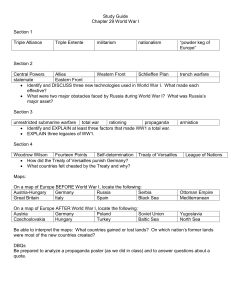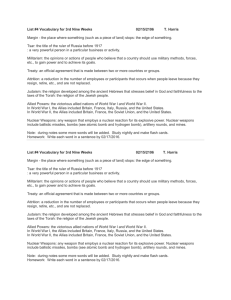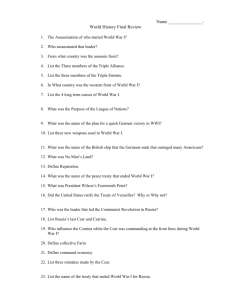TESTIMONY OF U.S. SECRETARY OF DEFENSE DONALD H. RUMSFELD
advertisement
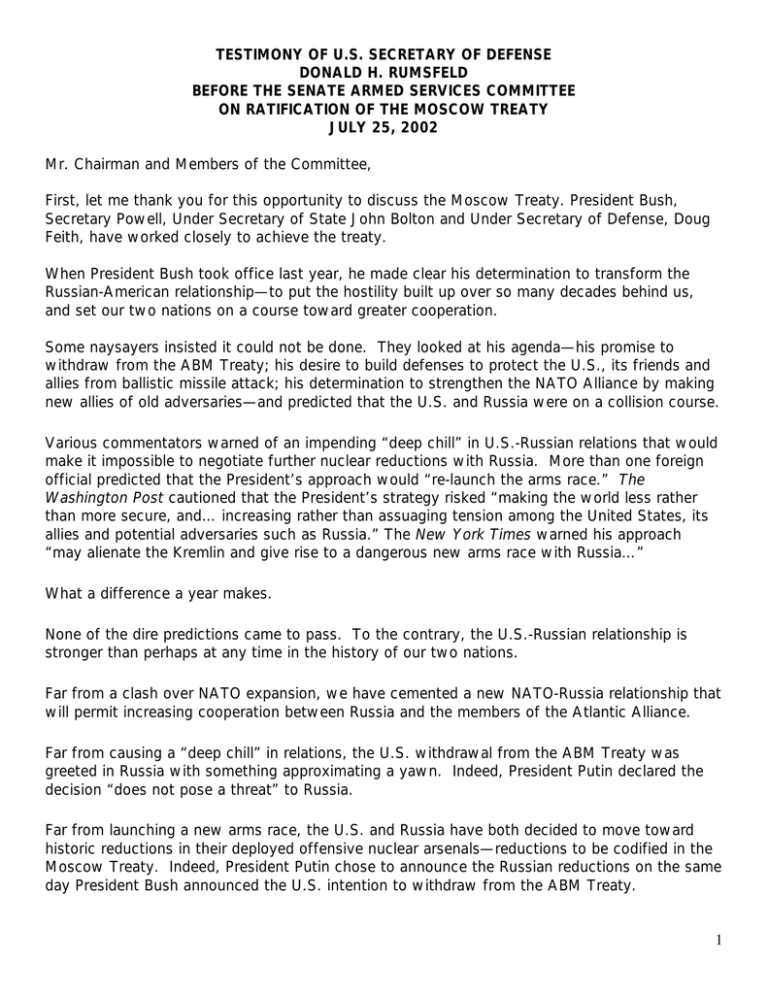
TESTIMONY OF U.S. SECRETARY OF DEFENSE DONALD H. RUMSFELD BEFORE THE SENATE ARMED SERVICES COMMITTEE ON RATIFICATION OF THE MOSCOW TREATY JULY 25, 2002 Mr. Chairman and Members of the Committee, First, let me thank you for this opportunity to discuss the Moscow Treaty. President Bush, Secretary Powell, Under Secretary of State John Bolton and Under Secretary of Defense, Doug Feith, have worked closely to achieve the treaty. When President Bush took office last year, he made clear his determination to transform the Russian-American relationship—to put the hostility built up over so many decades behind us, and set our two nations on a course toward greater cooperation. Some naysayers insisted it could not be done. They looked at his agenda—his promise to withdraw from the ABM Treaty; his desire to build defenses to protect the U.S., its friends and allies from ballistic missile attack; his determination to strengthen the NATO Alliance by making new allies of old adversaries—and predicted that the U.S. and Russia were on a collision course. Various commentators warned of an impending “deep chill” in U.S.-Russian relations that would make it impossible to negotiate further nuclear reductions with Russia. More than one foreign official predicted that the President’s approach would “re-launch the arms race.” The Washington Post cautioned that the President’s strategy risked “making the world less rather than more secure, and… increasing rather than assuaging tension among the United States, its allies and potential adversaries such as Russia.” The New York Times warned his approach “may alienate the Kremlin and give rise to a dangerous new arms race with Russia…” What a difference a year makes. None of the dire predictions came to pass. To the contrary, the U.S.-Russian relationship is stronger than perhaps at any time in the history of our two nations. Far from a clash over NATO expansion, we have cemented a new NATO-Russia relationship that will permit increasing cooperation between Russia and the members of the Atlantic Alliance. Far from causing a “deep chill” in relations, the U.S. withdrawal from the ABM Treaty was greeted in Russia with something approximating a yawn. Indeed, President Putin declared the decision “does not pose a threat” to Russia. Far from launching a new arms race, the U.S. and Russia have both decided to move toward historic reductions in their deployed offensive nuclear arsenals—reductions to be codified in the Moscow Treaty. Indeed, President Putin chose to announce the Russian reductions on the same day President Bush announced the U.S. intention to withdraw from the ABM Treaty. 1 In little over a year, the President has defied the critics and set in motion a transformation in U.S.-Russian relationship—one that is designed to benefit the people of both our nations, and indeed the entire world. And the record shows that it is a transformation that began before the terrible events of September 11th. President Bush laid out his vision for a new relationship in a speech at the National Defense University on May 1st of last year. When he met President Putin for the first time a month later in Slovenia, instead of the predicted fireworks, the two presidents emerged from their discussions expressing confidence that our countries could put past animosities behind them. Not only had the meeting far exceeded his expectations, President Putin declared, but he believed that “Russia and the United States are not enemies, do not threaten each other, and could be fully good allies.” President Bush announced they had both agreed that the time had come “to move beyond suspicion and towards straight talk; beyond mutually assured destruction and toward mutually earned respect… to address the world as it is, not as it used to be.” And over the course of the past year, they put those words into action. In the last twelve months, the Presidents of the United States and Russia had more interaction, and forged more areas of cooperation, across a broader range of political, economic and security issues, than at any time in the history of our two nations. Today, the United States and Russia are working together to develop new avenues of trade and economic cooperation. We are working together to fight terrorism, and deal with the new and emerging threats we will both face in this dangerous new century. And we are working together to reduce the number of deployed offensive nuclear weapons—weapons that are a legacy of the past, and which are no longer needed at a time when Russia and the U.S. are basing our relations on cooperation, not fear of mutual annihilation. These are historic changes—changes of a breadth and scale that few imagined, and many openly doubted, could be achieved in so short a period time. Of course there is still a great deal of work ahead—and challenges to overcome. Our success is by no means assured. But we have an opportunity to build a new relationship for our peoples— a relationship that can contribute to peace, stability, and prosperity for generations of Russians and Americans. It is ours to grasp—or to let slip away. But let there be no doubt—it will require a change in our thinking—thinking in our bureaucracies, in the Duma and the Congress, and in the press and in academic institutions. We have decades of momentum going in the opposite direction. We need to recalibrate our thinking and our approaches. 2 In both our countries, there are those who are still struggling with the transition. Tolstoy said, “everyone thinks of changing the world, but no one thinks of changing himself.” There is a reason for that. Change is not easy—none of us wakes up in the morning wanting to change. Habits built up over many decades become ingrained, and are hard to break. Here in the U.S., there are some who would have preferred to see us continue the adversarial arms control negotiations of the Soviet era—where teams of lawyers drafted hundreds of pages of treaty text, and each side worked to gain the upper hand, while focusing on ways to preserve a balance of nuclear terror. This is an approach that President Bush rejected, insisting instead that we deal with Russia as we deal with all normal countries—in a spirit of friendship, trust and cooperation. Similarly, in Russia today there are those who are stuck in the past—who look warily at American offers of greater friendship and cooperation, preferring to keep us at arms length, while continuing to associate with the old allies of the former Soviet Union—dictatorial regimes characterized by political, religious and economic repression—the world’s walking wounded. But there are others in Russia who want to see her embrace the future and take her rightful place in Europe—through increased integration with the Western industrialized democracies, and by embracing political and economic freedom, and the higher standard of living, domestic peace and thriving culture that are the product of free societies. Sometimes these divergent impulses can be found in the same people. Both of our nations have a choice to make—a choice between the past and the future. Neither of us can make that choice for the other. But each of us has an interest in the choice the other makes. The question for us is: what can we, who choose the future, do to support each other? For those of us in the business of national defense, our task is an important one: to clear away the debris of past hostility that has been blocking our path into the 21st century. Russia and the United States entered this new century saddled with two legacies of the Cold War: the adversarial relationship to which we had both grown accustomed, and the physical manifestation of that adversarial relationship—the massive arsenals of weapons we built up. In the past year, we have made progress in dealing with both. Last November, at the Crawford Summit, President Bush announced his intention to reduce the United States’ operationally deployed strategic nuclear warheads by some two-thirds—to between 1,700 and 2,200 weapons. Soon after, President Putin made a similar commitment. These announced reductions are a reflection of our new relationship. When President Reagan spoke to the students at Moscow State University in 1988, he told them, “nations do not 3 distrust each other because they are armed; they are armed because they distrust each other.” Clearly, we do not distrust each other the way the U.S. and Soviet Union once did. But what is remarkable is not simply the fact of these planned reductions, but how they have happened. After a careful review, President Bush simply announced his intention to cut our operationally-deployed nuclear warheads. President Putin did the same. When they met in Moscow, they recorded these unilaterally announced changes in a treaty that will survive their two presidencies—the Moscow Treaty which the Senate and the Duma will now consider. But it is significant that while we consulted closely, and engaged in a process that has been open and transparent, we did not engage in lengthy, adversarial negotiations in which the U.S. and Russia kept thousands of weapons they did not need as bargaining chips. We did not establish standing negotiating teams in Geneva, with armies of arms control aficionados ready to do battle over every colon and comma. If we had done so, we would still be negotiating today. Instead, we are moving toward dramatic reductions in the ready nuclear weapons of our two countries—and clearing the way for a new relationship between our countries. An illustration of how far we have come in that regard is this: [HOLDS UP START TREATY] This is the START I Treaty, signed in 1991 by the first President Bush and Soviet President Mikhail Gorbachev. It is 700 pages long, and took 9 years to negotiate. [HOLDS UP MOSCOW TREATY]. This is the Moscow Treaty, concluded this summer by President Bush and President Putin. It is three pages long, and took 6 months to negotiate. And, Mr. Chairman, we are working toward the day when the relationship between our two countries is such that no arms control treaties will be necessary. That is how normal countries deal with each other. The United States and Britain both have nuclear weapons—yet we do not spend hundreds of hours negotiating the fine details of mutual reductions in our offensive systems. We do not feel the need to preserve a balance of terror between us. It would be a worthy goal for our relationship with Russia to be the same. There are those who do not see the difference in the size of these treaties as a sign of progress. To the contrary, they would have preferred a voluminous, legalistic arms control agreement, with hundreds of pages of carefully crafted provisions and intrusive verification measures. 4 These critics operate from a flawed premise: that, absent such an agreement, our two countries would both try to break out of the constraints of this treaty and increase our deployed nuclear forces. Nothing could be further from the truth. During the Cold War, the stated rationale for arms control was to constrain an arms race. But the idea of an arms race between the United States and Russia today is ludicrous. The relationship between our two countries today is such that the U.S. determined—unilaterally— that deep reductions in our deployed nuclear forces are in the U.S. interest. We would have made these cuts regardless of what Russia did with its arsenal. We are making them not because we signed a treaty in Moscow, but because the transformation in our relationship with Russia means we do not need so many deployed weapons. Russia has made a similar calculation. The agreement we reached in Moscow is the result of those determinations—not the cause of them. That is also one reason we saw no need for including detailed verification measures in the treaty. There simply isn’t any way on earth to verify what Russia is doing with all those warheads. Neither side should have an interest in evading the terms of the treaty, since it codifies unilaterally announced reductions—and gives both sides broad flexibility in implementing them. Further, we saw no benefit in creating a new forum for bitter debates over compliance and enforcement. Today, the last place in the world where U.S. and Russian officials still sit across a table arguing with each other is in Geneva. Our goal is to move beyond that kind of Cold War animosity—not to find new ways to extend it into the 21st century. Similarly flawed is the complaint that, because the Moscow Treaty does not contain a requirement to destroy warheads removed from missiles or bombers, the cuts are reversible and therefore not “real.” Put aside for a moment the fact that no previous arms control treaty—not SALT, START or INF—has required the destruction of warheads, and no one offered objections to them on that basis. This charge is based on a flawed premise—that irreversible reductions in nuclear weapons are possible. In point of fact, there is no such thing as an irreversible reduction in nuclear weapons. The knowledge of how to build nuclear weapons exists—and there is no possibility that knowledge will be lost. Every reduction is therefore reversible, given time and money. Indeed, when it comes to building nuclear weapons, Russia has a distinct advantage over the U.S. Today, Russia can and does produce both nuclear weapons and strategic nuclear delivery vehicles—they have open warm production lines. The U.S. does not currently produce either ICBMs or nuclear warheads. It has been a decade since we produced a new nuclear weapon— and it would take us a number of years to begin producing them again. In the time it would take us to re-deploy decommissioned nuclear warheads, Russia could very likely produce a larger number of new ones. But the question is: why would we want to do so? Barring some unforeseen and dramatic change in the global security environment—like the sudden emergence of a hostile peer 5 competitor on par with the old Soviet Union—there is no reason why we would re-deploy the warheads we are reducing. The reason to keep, rather than destroy, some of those decommissioned warheads is to have them available in the event there is a problem with the safety or reliability of some element of our arsenal. Since we do not have a warm production line, it would be mindless for us to destroy all those non-deployed warheads, and then have nothing for back up in the event we run into safety and reliability problems—or a sudden, unexpected change in the global security environment. Russia, by contrast, has little or no need to maintain a reserve of warheads, since it has an active production capability. Mr. Chairman, if we had pursued the path of traditional arms control, as some suggested, we would not be proceeding with the reductions outlined in this treaty. Rather, we would still be at the negotiating table, arguing over how to reconcile these and other asymmetries between Russia and the United States. • We would have had to try to balance Russia’s active production capacity against the United States’ lack of one. • Russia might have insisted that any agreement take into account the size of the U.S. economy and our ability to mobilize resources relatively quickly to develop new production facilities. • We might have argued that Russia’s proximity to rogue nations allows them to deter these regimes with tactical systems, whereas, because they are many thousands of miles away from us, the United States’ distance from them requires more intercontinental delivery systems than Russia needs. • This could have resulted in a mind-numbing debate over how many non-strategic systems should equal an intercontinental system, or opened the door to a discussion of whether an agreement must include all nuclear warheads—including tactical warheads. • Russian negotiators might have countered that a U.S. advantage in advanced, high-tech conventional weapons must be taken into account. And so on and so forth, ad infinitum. But the point is this: We don’t need to “reconcile” all these asymmetries—because neither Russia nor the U.S. has an interest in taking advantage of the other by increasing its respective deployed nuclear forces. The approach we have taken is to treat Russia not as an adversary, but as a friendly power. In so doing, we have been able to preserve the benefits attributed to arms control—the dialogue, consultations, lower force levels, predictability, stability, and transparency. But we have done 6 so without all the drawbacks: the protracted negotiations; the withholding of bargaining chips; the legalistic and adversarial process that, more often than not, becomes a source of bitterness between the participants; and the extended, embittered debates over compliance and enforcement of agreements. The U.S. and Russia are moving beyond all that. We are working to put that kind of acrimony and hostility behind us—and the adversarial process that was both a cause and effect of that hostility. Because Russia and the United States are no longer adversaries, our interests have changed. As enemies, we had an interest in each other’s failure; as friends we have an interest in each other’s success. As enemies we had an interest in keeping each other off balance; as friends we have an interest in promoting stability. When Russia and the U.S. were adversaries, our principal focus was trying to maintain and freeze into place the balance of nuclear terror. With the recently completed Nuclear Posture Review, the United States has declared that we are not interested in preserving a balance of terror with Russia. Today, the threats we both face are no long from each other—they come from new sources. And as our adversaries change, our deterrence calculus can and should change as well. That is why we are working to transform our nuclear posture from one aimed at deterring a Soviet Union that no longer exists, to one designed to deter new adversaries—adversaries that may not be discouraged from attacking us by the threat of U.S. nuclear retaliation, just as the terrorists who struck us on September 11th were not deterred by the United States’ massive nuclear arsenal. With the Nuclear Posture Review, President Bush is taking a new approach to strategic deterrence—one that combines deep reductions in offensive nuclear forces, with new conventional offensive and defensive systems more appropriate for deterring the potential adversaries we face. Taken together, this “New Triad” of offensive nuclear forces, advanced conventional capabilities, and a range of new defenses (ballistic missile defense, cruise missile defense, space defense, cyber defense) supported by a revitalized defense infrastructure, are all part of a new approach to deterrence and defense—an approach designed to increase our security, while reducing our reliance on nuclear weapons. Some have asked why, in the post-Cold War world, we need to maintain as many as 1,7002,200 operationally-deployed warheads? The end of the Soviet threat does not mean we no longer need nuclear weapons. To the contrary, the U.S. nuclear arsenal remains an important part of our deterrence strategy, and helps to dissuade the emergence of potential or would-be peer competitors, by underscoring the futility of trying to sprint toward parity with us or superiority. 7 Indeed, Mr. Chairman, our decision to proceed with reductions as deep as the ones outlined in the Moscow Treaty is premised on decisions to invest in a number of other critical areas— programs that are funded in our 2003 budget request. These include investments to: • Improve U.S. intelligence collection, analysis, processing, and dissemination; • Protect the U.S. homeland, including a refocused and revitalized missile defense research and testing program, and capabilities to detect and respond to biological attack; • Accelerate development of UAVs with new combat capabilities, and produce fast, precision conventional strike capabilities; • Convert four Trident nuclear submarines into stealthy SSGN Strike Submarines that can carry cruise missiles and Special Operations Forces into denied areas; • Leverage information technology to seamlessly connect U.S. forces—in the air, at sea and on the ground; • Protect our information networks; • Improve the survivability of U.S space systems, and develop a space infrastructure that assures persistent surveillance and access. Investments in these, and many other transformational capabilities in the 2003 budget, will allow the U.S., over time, to reduce our reliance on nuclear weapons and enact the deep nuclear reductions contained in the Moscow Treaty. I urge the Senate to approve the 2003 defense budget as soon as possible. Others have asked why there is no reduction schedule in the treaty? The answer, quite simply, is flexibility. Our approach in the Nuclear Posture Review was to recognize that we are entering a period of surprise and uncertainty, when the sudden emergence of unexpected threats will be increasingly common feature of our security environment. We were surprised on September 11th—and let there be no doubt, we will be surprised again. When Bob McNamara appeared before the Senate for his confirmation hearings as Secretary of Defense, no one mentioned the word Vietnam. When Vice President Cheney appeared before the Senate for his Senate confirmation as secretary of defense, he did not, nor did any member of the committee, mention the word Iraq. When I appeared before the Senate Armed Services Committee for my confirmation hearings last year, no one—including me—mentioned the word Afghanistan. 8 Intelligence has repeatedly underestimated the capabilities of different countries of concern to us. We have historically have had gaps in our knowledge of 4, 6, 8, and in at least one case 12 or so years. It is simply not possible for intelligence to know everything taking place in our world. The only surprise is that so many among us are still surprised. This problem is more acute in an age when the spread of weapons of mass destruction into the hands of terrorist states—and potentially terrorist networks—means that our margin of error is significantly less than it has been. The cost of a mistake could be not thousands, but hundreds of thousands of lives—or even millions. Because of our smaller margin for error, and the uncertainty of the future security environment, the U.S. will need flexibility. Through the Nuclear Posture Review, we determined the force levels and the flexibility we will need to deal with that new world—and then negotiated a treaty that allows both deep reduction in offensive weapons and the flexibility to respond to sudden changes in the strategic environment. We are working develop the right mix of offensive and defensive capabilities. If we do so, we believe the result will be that nations are less likely to acquire or use nuclear weapons. None of these changes is in any way a threat to Russia. Far from it, this new approach to deterrence will help us to better contribute to peace and stability, and address the new threats and challenges the United States will face in the 21st century. In many ways, Russia now faces the most benign security environment it has enjoyed in more than 700 years. From the 13th century up till the dawn of the 16th century, Russia was subjected to Mongol rule; in the 17th century she was invaded by Poland; in the 18th century by Sweden; in the 19th century by France; and in the 20th century by Germany. Today, for the first time in modern history, Russia is not faced with a foreign invader with its eye set on Moscow. In the 21st century, Russia and the United States both face new and different security challenges—the threats of terrorism and fundamentalism and the spread of weapons of mass destruction to rogue states. The difference is that these are threats our two nations have in common—threats that we can face together. This means that we have entered a period when cooperation between our two countries will be increasingly important to the security and prosperity of both our peoples. We can work together to stop the spread of weapons of mass destruction into the hands of terrorist movements and terrorist states. We can work together to support Russia’s economic transformation and deeper integration into the Euro-Atlantic community—because a prosperous Russia would not face the same pressures to sell rogue states the tools of mass destruction. If one were to look down from Mars on Earth, one would see that the world divides pretty neatly into countries that are doing well and countries that are not doing well. The countries that are doing well are the ones that have free political systems, free economic systems, rule of law, transparency and predictability, and are integrated into the world economy. They are the nations where there is growth and opportunity. 9 If Russia hopes to attract foreign capital, or retain her most gifted, best educated citizens, she must provide them with a climate of economic opportunity and political freedom—a climate that is the critical foundation on which prosperity, creativity and opportunity are built. We in the United States can encourage Russia—by working together to put the past behind us, establish bonds of friendship between our peoples. But, in the end, the choice, and the struggle, belong to the Russian people. This treaty is by no means the foundation of that new relationship. It is merely one element of a growing, multifaceted relationship between our two countries that involves not just security, but also increasing political, economic, diplomatic, cultural and other forms of cooperation. These reductions in the nuclear arsenals of our two countries are a step in that process. The reductions characterized in the Moscow Treaty will help eliminate the debris of past hostility that has been blocking our way as we build a new relationship. The Treaty President Bush has fashioned—and the process by which he fashioned it—are both models for future cooperation between our two countries. We have achieved deep reductions, and enhanced the security of both our countries, without perpetuating a Cold War ways of thinking that hinder a desire for better relations. I urge the Senate to advise and consent to this treaty, and to approve a clean resolution of ratification. I’d be pleased to respond to your questions. Any questions that cannot be fully answered here, we will be pleased to answer in classified session, or later for the record. ## 10
